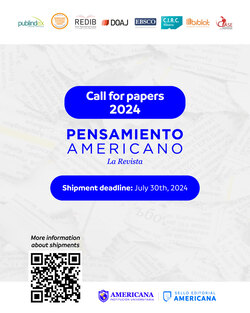A multidimensional approach to the Exodus Shrine as God's Revelation
DOI:
https://doi.org/10.21803/pensam.v11i21-1.281Keywords:
Éxodo, Revelación de Dios, Santuario, TabernáculoAbstract
The sanctuary of Exodus is an experience referred to biblical historiography, where the experience of salvation is analogous. This paper uses a conceptual approach to the sanctuary from the anthropological, architectural and pedagogical perspectives so that the 21st-century student can appropriate the critical concepts of this biblical truth. The use of mobile technology encourages learning and motivates visitors to explore the semantic and transcendental depth behind the Exodus sanctuary.
Downloads
References
Albright, W. F. (1940). The ancient Near East and the religion of Israel. Journal Of Biblical Literature 59(2). 85.
Arboleda, J. C. (2015). El curri?culo desde la pedagogi?a comprensivo-edificadora. Revista Educacio?n y Pensamiento 22(22). 47 – 65.
Barclay, W. (1995). Comentario al Nuevo Testamento. Tomo 8. Barcelona, Epan?a: Editorial Clie.
Betts, A. (2012). Nomads, tribes, and the state in the ancient Near East: cross-disciplinary perspectives. Bulletin Of The American Schools Of Oriental Research 366, 88-90.
Blumenthal, F. (2012). The ten plagues: debunking Egyptian polytheism. Jewish Bible Quarterly, 40(4), 255-258.
Collins, S. V., Colllins, M. A., Corte?s, A. F., Peverini, T. N., & Valdivia, M. A. (2005). Teologi?a: Fundamentos bi?blicos de nuestra fe. Miami, Fla: Asociacio?n Publicadora Interamericana.
Davidson, R. M. (1981). Typology in Scripture: A Study of Hermeneutical Typos Structures Berrien Springs, Mich.: Andrews University Press.
Duarte D., J. (2003). AMBIENTES DE APRENDIZAJE: UNA APROXIMACION CONCEPTUAL. Estudios Pedago?gicos, (29), 97-113.
Fiorodovna, N. (1994). La teori?a de la actividad de estudio, como base de la dida?ctica en la educacio?n superior. Me?xico: Universidad Auto?noma Metropolitana.
Fountain, T. (1984). Claves de la interpretacio?n bi?blica El Paso, Tx.: Casa Bautista de Publicaciones, 78.
Frorer, P., Hazzan, O. & Manes, M. (1997). Revealing the faces of abstraction. International Journal of Computers for Mathematical Learning2(3).217-228.
Garci?a Avile?s, J. A. (2009). La comunicacio?n ante la convergencia digital: algunas fortalezas y debilidades. Signo y pensamiento, 28(54), 102-113.
Goldstein, C. (1994). Desequilibrio fatal: La verdad acerca del juicio, el santuario, y su salvacio?n. Buenos Aires, Argentina: ACCES.
Gonza?lez, J. L. (1992). Historia del pensamiento cristiano Miami: Caribe. 43-45.
Gresham, J. (2006). The divine pedagogy as a model for online education. Teaching Theology & Religion 9(1), 24-28.
Haskell, S. (2011) La Sombra de la Cruz. USA: Asociacio?n Publicadora Interamericana.
Holbrook, F. B. (1996). The atoning priesthood of Jesus Christ. Berrien Springs, Mich: Adventist Theological Society Publications.
Jonassen, D. H. (1991). Evaluating Constructivistic Learning. Educational Technology, 31(9). 28 – 33.
Kotiadis, K. & Robinson, S. (2008). Conceptual modelling: knowledge acquisition and model abstraction. In Proceedings of the 40th Conference on Winter Simulation, pp. 951-958. Winter Simulation Conference.
Martin, R. (2003). Agile software development: Principles, patterns, and practices. Upper Saddle River, N.J: Prentice Hall.
Marti?nes, C (2012). Principios epistemolo?gicos para la comprensio?n de la doctrina del santuario. Davar Logos 11(1). 1 – 17.
Matthews, V. H. (1981). Pastoralists and patriarchs. Bibli- cal Archaeologist 44(4). 215-218.
Millanao, P. (2011). Cristologi?a: Sus rai?ces y frutos en el santuario. Revista Adventista. Recuperado de: https://porundia.files.wordpress.com/2008/05/cristologia.pdf
Moffatt, J. (1924). The Epistle to the Hebrews. Edimburgh.
Philip, J. (1995) The Levitical Sacrifical System, in Royer T. Beckwith y Martin J. Selman, “Sacrifices in the Bible” Grand Rapids, Mich.: Baker Books House.
Real Academia Espan?ola. (1970). Diccionario de la lengua espan?ola. Madrid: Real Academia Espan?ola.
Ri?os, S. (1995) Modelizacio?n. Espan?a: Alianza Editorial.
Rodri?guez, A?. M. (2006). La doctrina del santuario» en Teologi?a: Fundamentos bi?blicos de nuestra fe, tomo 4. Doral, FL: APIA, 109.
Sailhamer, J. H. (1992). The Pentateuch As Narrative: A Biblical-Theological Commentary Grand Rapids, Michigan: Zondervan.
Sharples, M., Taylor, J. & Vavoula, G. (2005). Towards a theory of mobile learning. Proceedings of mLearn 2005, 1(1), 1-9.
Trenchard, E. (1973). Normas de interpretacio?n bi?blica Madrid, Espan?a: Editorial Literatura Bi?blica, 92-93
Wright, G. E. (1952). God Who Acts: Biblical Theology as Recital, 61.
Downloads
Published
Issue
Section
License
Copyright (c) 2018 Pensamiento Americano

This work is licensed under a Creative Commons Attribution-NonCommercial-NoDerivatives 4.0 International License.
The author or authors of an article accepted for publication in the Journal Pensamiento Americano will transfer all of the patrimonial rights to the American University Corporation free of charge, within which are included: the right to edit, publish, reproduce and distribute both print media as digital, in addition to include in article in international indexes and / or databases, likewise, the Editorial Seal is authorized to use the images, tables and / or any graphic material presented in the article for the design of covers or posters from the same magazine. By assuming the patrimonial rights of the article, it may not be partially or totally reproduced in any printed or digital media without its express permission.
AUTHORITY ASPECTS
For the Pensamiento Americano Journal, all the authors of an article have made substantial contributions to the research and the manuscript, and they share the responsibility when the article presents errors, fraud in some way or violations of copyright.
After submitting an article, the journal does not accept the addition, deletion or change in the order of the authors, in addition we reserve the right to release the article when it has been submitted to the journal and under no circumstances will American Thought accept the article. withdrawal of an article during any phase of the editorial process






